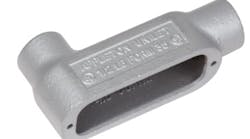Something as simple as installing conduit bodies (such as LBs) should require little thought as far as sizing goes, especially in cases where there are no splices involved. Surprisingly enough, this is one area of the NEC that is often violated. The issue is the minimum bending radius required for the conductors. Let’s run through an example to explain this situation.
Say we have a ¾-in. rigid metal conduit (RMC). We installed 20 ft of conduit, including a couple of ¾-in. LB conduit bodies along the way. Inside the conduit we’ve installed one, 600V, 7/C, 12 AWG, Type TC-ER cable. The individual conductors are type XHHW-2. We looked up the manufacturer’s data on the cable and find the O.D. is 0.59 in.
Just to be sure that we’ve sized the conduit adequately, let’s check the conduit size. We’re allowed a 53% fill maximum as per NEC Chapter 9, Table 1, and Notes to Tables [Note (9)]. We’re going to use a cable that has an actual O.D. of 0.59 in. (area = 0.273 in2) in accordance with Note (5). Looking at Chapter 9, Table for Art. 344, we see that the maximum conduit fill allowed is 0.291 in2. Great! Our conduit size should be large enough for a short pull.
Next, we check the bending radius from the cable manufacturer, and find that they require a minimum bending radius of four times the O.D. of the cable: 4 x 0.59 in. = 2.36 in. radius (minimum).
Now we check the minimum bending radius that the fitting will allow. Fitting bend radius and fill information is available from the conduit body manufacturer and is also typically found on their web site or through the local manufacturer representative. In this case, we’re going to use a Form 8 LB, malleable iron, which is much larger than a Form 7. However, even the Form 8 condulet only has an allowable bending radius of 2.1 in. per the manufacturer literature that we’re using in this example. The next trade size larger is a 1-in. LB with a minimum bending radius of 2.5 in.
So, based on our example scenario, we would need to install a 1-in. LB. Finding something like this after the conduit is installed can result in either damaged cable or a costly rework situation. It’s also important to note that the minimum bending radii for different brands of “Form 8” fittings vary.
© 2018 Fluor Corporation. All Rights Reserved.



